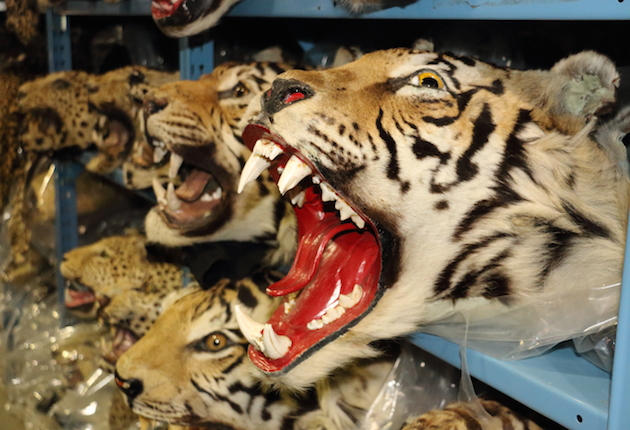From the July/August 2008 issue of Sporting Classics.
I’m surrounded by dead animals. It’s overwhelming, and my eyes can’t fix on any one item: Elephant feet here. Tiger heads there. Eagles on high shelves. Seahorses on lower. The collection is massive and gruesome, the effects of wildlife trafficking. I can’t help but stare wide-eyed for a moment before clearing my head and rolling my video camera.
EarthFix, a division of PBS, commissioned me to do a story on the illegal eagle trade, and the project led me here, to the National Eagle and Wildlife Property Repository outside Denver, Colorado. This is where the US Fish and Wildlife Service stores evidence from trafficking cases after the judicial proceedings conclude. The collection is the result of nationwide efforts by law-enforcement officers and wildlife agents to confiscate and seize goods made from endangered species. I look around: Snake wine. Antelope scarves. And bins and bins of elephant tusks, crushed as if Grandma’s china cabinet had fallen on its side. But the ivory didn’t arrive at the warehouse like this—FWS destroyed it. In 2013, the service pummeled six tons of it with an industrial rock crusher, and now the bins join the repository’s more than one-million-piece evidence collection.
“It was crushed as a statement that the trafficking of elephant ivory was no longer going to be tolerated,” says Coleen Schaefer, who directs the repository. “We eliminated the value . . . in order to stem poaching.”
The repository opened in the 1980s, and some items have been here since the beginning, but the collection continues to grow. Coolers filled with eagles show up the day I arrive. After bald and golden eagles—dead of natural causes or killed illegally—arrive, FWS distributes the feathers, talons, wings, and other parts to Native American tribes, who use them for ceremonies and religious services. While the eagles are repurposed, almost nothing else leaves the shelves of this museum-like warehouse.
“Most of what we have is illegal, in one form or another,” Schaefer says. “Sometimes I can remove myself from looking at all that, but when I give a tour and we talk about specific pieces, it’s devastating. Wildlife has been reduced, in some cases, to something that is completely whimsical.”
Two hours later I finish filming and wander the aisles, fixated on the strange spectacles that once roamed the wild. I come upon items made from animals that inhabit the West, my longtime home: eagle talons, elk antlers, deer hides. I hate seeing them here in this condition, crowded on these shelves, far removed from their natural state. I hate they were illegally traded. But at least this is not my first impression of them: I’ve seen these creatures alive and in abundance in the wild.
But I haven’t seen an elephant in person, and I’m drawn to the section that houses their remains. Their huge feet double as flowerpots, footrests, and wastebaskets. There’s a pile of elephant-hair bracelets and a stack of hides. Among the stash, I spot two tusks, carved delicately into the shapes of a man and a woman, leaning toward each other. How hands of such harm can create such beauty escapes me.
I study the carvings closely then notice what is propped on the wall behind them: a large elephant skin cut into the shape of Africa with a painting of an elephant in motion, its ears fanned widely. I would find such a sight in the wild amazing, and I hope to witness it one day—but, staring at an animal painted on its own skin, I fear I may never have the opportunity.
This is the reality of wildlife trafficking, packed into this repository, in a warehouse outside Denver.
Subscribe to the free daily newsletter to have Sporting Classics stories sent directly to your inbox!

